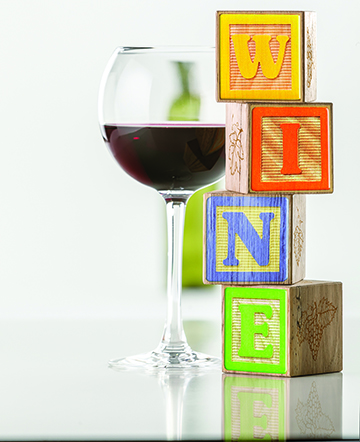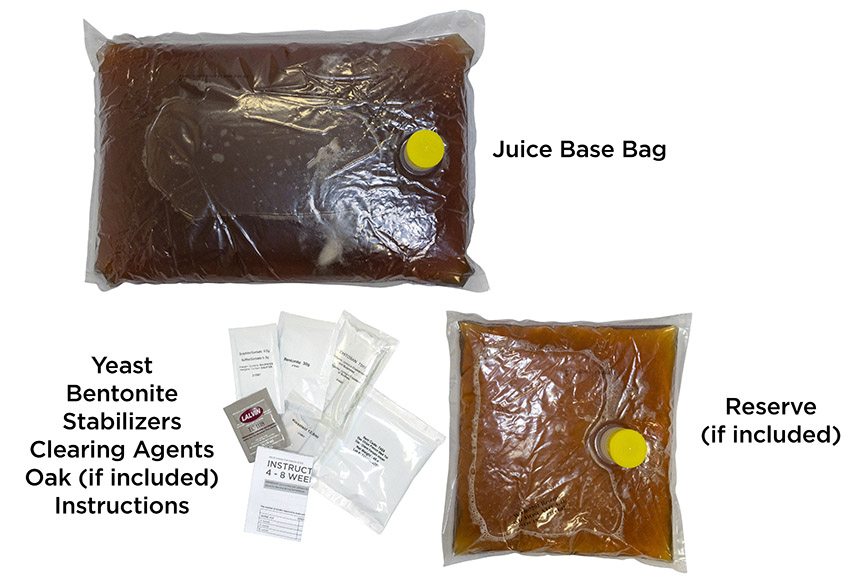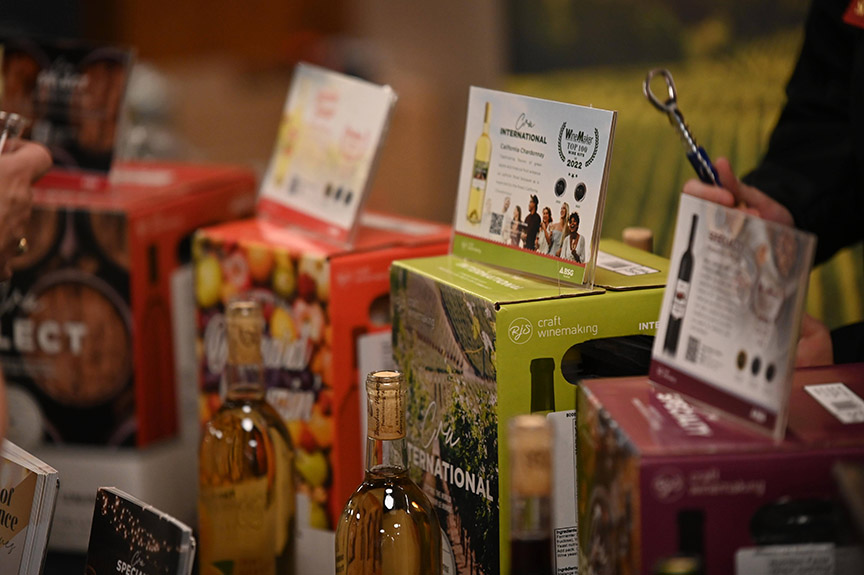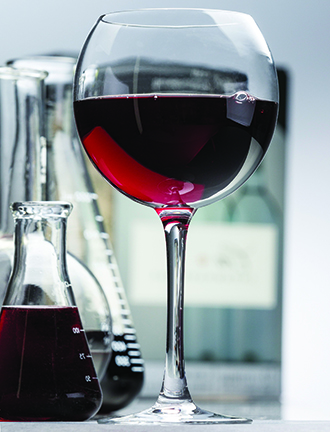
There was a time not all that long ago when the idea of easy, user-friendly access to high-quality varietal grape juices from the world’s best growing regions was the stuff of dreams. But, with necessity and the discerning taste buds of thirsty wine drinkers being the mother of invention, the first winemaking kit was born.
For North American home wine enthusiasts of the 1960s — many with roots going back to European regions steeped in traditions of excellent, inexpensive wine on every table — these new products offered a unique opportunity to make quality wine 12 months a year regardless of local climate. At the same time, a whole new generation of interested hobbyists looking for a fun and delicious project discovered the joys of home winemaking and helped to fuel the drive for quality and innovation in this burgeoning industry.
The first wine kits were invented in the late 1950s on the west coast of Canada by a company called Wine Art. Taking inspiration from other easy-to-use juice concentrates like orange juice, they applied the same technology and created the earliest incarnation of the wine kit. The first kits were introduced as canned grape concentrate with separate packets of tannin, yeast, oak extract, and sugar bundled
together and sold in very limited wine styles.
Unfortunately, this early technology could only offer juice that was affected by the high temperatures necessary in the canning process, resulting in consistency and quality issues with the finished product. Eventually, pasteurization was introduced and was a game changer. Pasteurization heated the juice just long enough to kill any potential spoilage bacteria while preserving the quality and allowing the juice base to be bagged, avoiding the canning process. Pasteurization also removed the risk of over-caramelization, and resulted in a fresher tasting, truer-to-style wine with better color and more robust aromatics. From this point, there was no looking back for the kit manufacturers like Winexpert, VineCo, Mosti Mondiale, and RJS Craft Winemaking.
How Kits are Made Today
The journey from raw materials to a winemaking kit is as close to a perfect science as winemaking will ever be. There is an art/science relationship to kit winemaking that requires a specific set of skills. Winemakers are responsible for creating consumer-friendly kits with an optimal balance between acid, tannin, alcohol, and sweetness that allows aromatics and fruit flavors to shine through in the finished wine.
Every wine style at every brand level goes through multiple bench trials to determine the best formulation that reaches the quality benchmark set by the winemakers and the tasting panel employed by the kit companies.
The search for the very best fruit from each year’s harvest never ends. Juices are sourced from both hemispheres to ensure consistent twelve-month supplies. The juice and concentrate comes across the ocean on tankers before being loaded into tanker trucks and delivered to the production facility where samples are taken on site from the waiting truck. If the Brix and other sample test results are not in line with expectations, the shipment will be refused. Once the shipment has been accepted, it is transferred into a cold tank or sometimes frozen until it will be used. Everything that goes into the kit is assembled on the production line in a single run, including filling the juice bag and adding the specific oak packets and appropriate additives. Even the box is folded into shape and glued shut on the line. It is a fascinating production to watch.
Samples are taken during the production run to ensure consistency in the batch by the quality control team. Testing is performed at the on-site lab to ensure that the end product meets all expectations before it leaves the plant. There is also a team member who makes one kit of every new wine style produced, following the instructions just as a home winemaker would, to ensure that the kit performs as expected. These finished wines are then tasted by the winemaker to ensure they deliver on the high quality that is expected. Once the manufacturing process is complete, the kits are transported to the warehouse where wholesale orders are filled and shipped to retailers around the world.
Kit companies use inspiration, market trends, and even customer suggestions to determine the winemaking kit core portfolio. Limited release kits are influenced the most by market trends and customer feedback. Winemakers put a lot of thought into all of the formulations, but they work especially hard to create memorable limited release wines that are rarely, if ever, repeated. Juice for these kits is often sourced from specific and sometimes hard-to-get grape growing regions famous for that distinct varietal. These juices are often available in very limited supply since commercial wineries are also anxious to get their hands on the same juice. Occasionally, unusual oaks are sourced as well to achieve specific taste profiles. All of these components are gathered from around the globe to create a limited release kit. It’s really quite an amazing feat of planning and it requires continuing, long-standing relationships with brokers in the juice industry to bring these special selections to home winemakers each year. These kits are so limited that they are usually pre-sold and there are rarely extras available for sale.
Before any wine style goes into production, bench trials are performed to determine the optimum taste profile, aromatics, and color. Various oaks, yeast strains, tannins, sweetness levels, and acid combinations are all trialed at this time. There might be a dozen or more initial samples for the winemakers to evaluate. The sample flight will then be whittled down to a selection of four to six options. A blind tasting by a panel of in-house judges then decides the final sample that best fits the flavor profile and will ultimately go into production. This protocol is used for the introduction of every new wine style.
Launching a new product or limited release can take as long as two years from determining the desired wine style, to sourcing the juice, to sourcing oak (if being used), to delivery. Next is fermenting and sensory analysis of a pre-shipment sample, to bench trials, to choosing the perfect blend, and finally, to production.
Of course, there is a core group of wine kits that will likely never be moved on to the discontinued list because of their popularity. The most popular white wine kit by far is Pinot Grigio and the all-time favorite red is Merlot. The unending popularity of these wine styles crosses all brand levels and price points.
Making World-Class Wine at Home
Kit production has come a very long way. Many of today’s production facilities have the same certifications and strict operating standards as other large food manufacturers. With today’s kit winemaking the guesswork has been taken care of and, as long as the home winemaker uses basic winemaking protocols, they are virtually guaranteed 28 to 30 bottles of quality table wine with every batch. These common-sense procedures include impeccable cleaning and sanitizing of all equipment and bottles, using good-quality drinking water in the process (chlorine must be filtered out), following all instructions, and cellaring the finished wine appropriately.
Today’s kits contain a juice base that is pre-balanced, which means no need for pH or titratable acidity testing or adding nutrient or energizer to ensure full fermentation, and the Brix is pre-determined to ensure a balanced wine with an appropriate final alcohol.
What else is in a winemaking kit? To follow is a list of items included. The contents will vary slightly depending on the wine style you choose.
In every kit:
Yeast – Hard-working organisms that convert sugar (in the must) into alcohol (in the finished wine).
Bentonite – Sterilized clay that helps to disperse yeast throughout the must, remove proteins that can impact the flavor of wine, and aid in the clearing process.
Potassium metabisulphite – A stabilizer that prevents spoilage and stops fermentation.
Potassium sorbate – A stabilizer used in tandem with potassium metabisulphite to inhibit further yeast growth.
Kieselsol (key-sel-sol) – A fining agent that binds with suspended particles in the wine to aid in clearing. Used in tandem with chitosan.
Chitosan (ky-toe-zan) – A fining agent that binds with suspended particles in the wine to aid in clearing. Used in tandem with kieselsol.
Isinglass (eye-sing-las) – A form of collagen used as a fining agent to aid in clearing. A stand-alone clearing agent.

Included in select wine style kits:
F-pack (flavor pack) – Included mostly in fruit wine kits to add sweetness and each style’s unique flavor.
Grape skin packs – These packs may be dried or crushed grapes to add tannin and structure to the finished wine; usually found in ultra-premium kits.
Oak chips, powder, or cubes – Adds flavor, tannin, structure, and aromatics to certain wine kits, usually red wines.
Reserve pack – Used to sweeten and balance a finished off-dry wine; may contain juice and sweetener or sweetener only.
Chaptalization pack – To be added at an exact point in the winemaking process to increase the final alcohol content for dessert wines.
Equipment Requirements
With some basic winemaking equipment, anyone can now make an excellent wine that will be ready to drink in 4–8 weeks. The key equipment required to make wine from start to finish includes:
• 8-gallon (30-L) plastic fermenter with lid
• 6-gallon (23-L) carboy (two would be ideal)
• Airlock with stopper to allow gas to escape and nothing to fall into the wine
• Long mixing spoon
• Good-quality drinking water (chlorine free)
• Hydrometer to monitor the fermentation progress
• Bottles, corks, and corker
Above are the basic items needed to get you started, but there are others that can be helpful, like an electric drill attachment that will speed up the degassing step and be easier on your arm vs. stirring with a long spoon. A stick-on or glass winemaking thermometer is also handy to ensure the temperature is in line with the instructions.
Types and Sizes of Kits
No matter what your local climate is like, the time of year it is, or your skill level, you can take a winemaking journey around the world from your home winery. Just imagine fermenting a gorgeous Tempranillo from Spanish grapes in the middle of a cold Michigan January. Kit winemaking really is a sensory adventure to some of the world’s finest winemaking regions.
If you’re new to the hobby, at this point you may be interested in making wine and the question on your mind is, “Which kit should I make?”
I’m asked this question all the time and it’s my least favorite one to answer. By answering, I feel like I’m stealing one of the most fun decisions you will make in your day and one of the most satisfying parts of home winemaking. Not to mention that everyone would be making Bordeaux-style reds and Sauvignon Blanc if they went with my answer.
If you have never made wine from a kit, I recommend choosing what you would buy at your wine store if you were picking something out for yourself. If Cabernet Sauvignon is your go-to, then start there. If, however, you are feeling more daring, feel free to choose a style you’re less familiar with and go on a winemaking adventure. You just might find that an Australian Mataro Shiraz blend is the wine of your dreams. Or, perhaps a Grenache rosé with its delicate color and fresh strawberry nose will be the wine you didn’t know you loved.

For today’s home winemaker there are so many wines to choose from, beginning with the classics like Shiraz/Syrah, Pinot Noir, and Chardonnay. But don’t overlook the more unique and, some might say, underrated offerings like Carménère, Malbec, and Viognier. There are also lovely blends like the classic Alsace-style white blend of Gewürztraminer and Riesling, or the popular southern Rhône-style red blend of Grenache, Shiraz, and Mourvèdre. And, of course, there are also a whole selection of fruit wine kits. A few of the most popular flavors include black cherry, green apple, peach apricot, and strawberry watermelon, but there are so many more to choose from. Fruit wine kits are lower alcohol and meant to be easy, fun sippers. These wines are also outstanding when carbonated, if you happen to have carbonation equipment. There are also seasonal dessert wine kits and the highly anticipated limited releases.
Winemaking Kit Size Levels
Kit sizes are divided into four main categories by size, and most popular wine styles can be found in more than one size. Kits use a “Good, Better, Best” model when describing sizes, similar to commercial wines. All kits make excellent wine — deciding which kit to purchase depends on your expectations, palate, and budget. Larger kits will contain more varietal juice and concentrate. The largest size offerings will contain region-specific juice and more varied oaks depending on the kit, creating a more structured, rich wine, often with higher alcohol. Medium-range kits generally contain country-specific juice and concentrate, more limited oaking styles, and no grape skins. Smaller kits make delicious, budget-friendly wine that is meant to be approachable and easy to drink.
If I am making a red wine, I might go for the larger kits with heavier body and richer tannin structure. However, if I am choosing a white wine, I will usually go for the 4-week kit with its more medium body and early drinkability, though these are just my own personal preferences. It really all depends on what you are looking for and where your budget lies.
8-Week Table Wine — Makes 6 gallons (23 L)
These are ultra-premium, top-of-the-line kits and feature the finest varietal juices from the world’s best growing regions – like the Italian Piedmont or California’s Stag’s Leap districts. Limited release kits are usually found at this brand level. The finished alcohol range is typically between 13% and 14% depending on the wine style.
6-Week Table Wine — Makes 6 gallons (23 L)
These are premium kits that occasionally have a limited release and are from the world’s most sought-after grape growing countries. The expected finished alcohol ranges between 11–13.5% depending on the wine style.
4-Week Table Wine — Makes 6 gallons (23 L)
These kits make approachable, easy-drinking wine and are often country-specific. If you have never made kit wine before, these are a great place to start. The expected finished alcohol level will be between 11–13% depending on the wine style. Moscato will have a potential alcohol of 8.5%.
4-Week Fruit Wine — Makes 6 gallons (23 L)
These are a great alternative to traditional table wine. They are fun and fruity with excellent balance. Occasionally there will be limited release kits with interesting on-trend flavors. Generally, fruit wine or “mist-style” wines will have a potential alcohol content of 6% for finished wine.
6-Week Dessert Wine — Makes 3 gallons (11.5 L)
These are seasonally released kits that are traditionally bottled in 375-mL bottles. Dessert wines are higher in alcohol and have an extra step of chaptalization to reach 17% for finished wine. Often dessert wines will have limited release flavors like chocolate raspberry and mocha. Ice wine-style kits are also seasonally available and have a potential alcohol of 13%.
4-Week 1 gallon (3.8 L)
This is a fun way to dip your toes into winemaking. The kits are made using the same method as larger kits, but everything is done in 1-gallon (3.8-L) jugs. These kits are available in the most popular wine styles and alcohol will vary depending on style. If you like red but want to have a little white on-hand or vice versa, this might be the right kit size to balance your wine cellar.
Raise a Glass to a Uniquely Rewarding Hobby
The world of kit winemaking is a wonderful way to fill out your wine cellar and experience making varietals from around the world that you would never typically have access to. Starting from kits also ensures that your batches will be consistent over and over again and always ready to share with family and friends, whether you’re having a large celebration or just a quiet night at home.
There is a worldwide community of hobby wine enthusiasts who are some of the most fun and engaging people you could ever hope to meet. Today it is easier than ever to reach out and connect with your fellow winemakers, either online or at in-person events and conferences. Many cities have home winemaking clubs that embrace kit winemaking. Local winemaking shops are a great place to chat with knowledgeable winemakers and many of them will offer kit winemaking classes. Some shops also have a ferment-on-premise option. If you’re competitive, kit wines often hold their own against wines from fresh fruit and bring home medals from wine competitions in which they compete side-by-side.
For anyone who has never tried kit winemaking before, we like to say that the satisfaction of making that first batch in your basement is one of the great joys in life — just like a glass of good wine.







